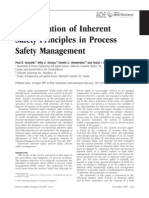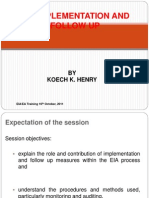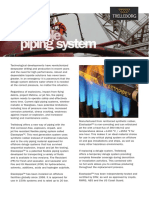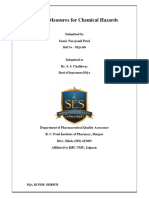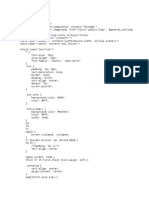Buncefield Presentation CI
Buncefield Presentation CI
Uploaded by
apicar_66Copyright:
Available Formats
Buncefield Presentation CI
Buncefield Presentation CI
Uploaded by
apicar_66Copyright
Available Formats
Share this document
Did you find this document useful?
Is this content inappropriate?
Copyright:
Available Formats
Buncefield Presentation CI
Buncefield Presentation CI
Uploaded by
apicar_66Copyright:
Available Formats
Combustion Institute British Section: Spring Meeting 2010
The Buncefield Oil Depot Explosions
11th December 2005
Dougal Drysdale, University of Edinburgh Independent Member of the Board of Investigation
www.buncefieldinvestigation.gov.uk
1
Combustion Institute British Section: Spring Meeting 2010
Hemel Hempstead
Combustion Institute British Section: Spring Meeting 2010
Direction from which next image is taken
M1
Buncefield Oil Storage and Transfer Depot
Combustion Institute British Section: Spring Meeting 2010
Tank 912
Northgate Building M1
Bund A Fuji Building
Buncefield Lane
Combustion Institute British Section: Spring Meeting 2010
Tank 912
Northgate Building M1
Bund A
~200 m
Buncefield Lane
Combustion Institute British Section: Spring Meeting 2010
The Incident
On Sunday 11 December 2005, a number of explosions occurred. A main explosion of massive proportions occurred at 06:01:32. There was a large fire, which engulfed over 20 large fuel storage tanks over a high proportion of the site. 43 people injured in the incident, none seriously. No fatalities. Significant damage occurred to both commercial and residential properties. About 2,000 people were evacuated. Sections of the M1 motorway were closed. The fire burned for five days, destroying most of the site and emitting large plume of smoke into the atmosphere, dispersing over southern England and beyond. Fuel supplies to SE England were seriously disrupted
Combustion Institute British Section: Spring Meeting 2010
Northgate Building
From W
Combustion Institute British Section: Spring Meeting 2010
From N
Classic example of an inversion layer
Combustion Institute British Section: Spring Meeting 2010
Fire in Northgate Building
Combustion Institute British Section: Spring Meeting 2010
City of London
Canary Wharf
From S
Combustion Institute British Section: Spring Meeting 2010
The Response
Agencies involved: Hertfordshire Police (co-ordinating) Hertfordshire Fire and Rescue Service (HFRS) Hertfordshire County Council Dacorum Borough Council Environment Agency Health Protection Agency HFRS supported by 32 other brigades in some capacity At the peak of the fire on 12 December, 180 fire fighters were involved on site More than 750 000 litres of foam concentrate were used, together with 55 million litres of water and 30 km of high-volume hose.
Combustion Institute British Section: Spring Meeting 2010
Combustion Institute British Section: Spring Meeting 2010
BPA Tank 12
Combustion Institute British Section: Spring Meeting 2010
12
Remains of the pumphouse
915
912
910
Water tank
From W
Combustion Institute British Section: Spring Meeting 2010
912
Tank 12
The pumphouse From N
Combustion Institute British Section: Spring Meeting 2010
12
Remains of the pumphouse
915
912
910
Water tank
From W
Combustion Institute British Section: Spring Meeting 2010
Tank 912
Buncefield Lane Three Cherry Trees Lane
Combustion Institute British Section: Spring Meeting 2010
Tank 912
Northgate Building M1
Bund A
~200 m Fuji Building
Three Cherry Trees Lane
Buncefield Lane
Combustion Institute British Section: Spring Meeting 2010
Northgate Building
Combustion Institute British Section: Spring Meeting 2010
Fuji Building
Combustion Institute British Section: Spring Meeting 2010
Tyres deflated forced off their seals
Damaged car found between the Northgate and Fuji Buildings
Combustion Institute British Section: Spring Meeting 2010
Fuji Building
Damaged van in the Northgate Building Car Park
Combustion Institute British Section: Spring Meeting 2010
Tank 12
Line of damaged cars in Three Cherry Trees Lane (north of the Car Park)
Combustion Institute British Section: Spring Meeting 2010
24
Combustion Institute British Section: Spring Meeting 2010
The Investigation
Joint Competent Authority of HSE and the Environment Agency under Control of Major Accident Hazard (COMAH) Regulations 1999 Investigation established by the Health and Safety Commission under Section 14.2a of the Health and Safety at Work etc. Act 1974 Decision taken NOT to have a Public Inquiry Lord Newton invited to Chair an Independent Investigation Board of six, including two members external to the joint Competent Authority Eight Terms of Reference laid down
Combustion Institute British Section: Spring Meeting 2010
The Board
Combustion Institute British Section: Spring Meeting 2010
Eight Terms of Reference 1. To ensure the thorough investigation of the incident, the factors leading up to it, its impact both on and off site, and to establish its causation including root causes causes; 2. To identify and transmit without delay to duty holders and other appropriate recipients any information requiring immediate action to further safety and/or environmental protection in relation to storage and distribution of hydrocarbon fuels; 3. To examine the Health and Safety Executives and the Environment Agencys role in regulating the activities on this site under the COMAH regulations, considering relevant policy guidance and intervention activity; 4. To work closely with all relevant stakeholders, both to keep them informed of progress with the investigation and to contribute relevant expertise to other inquiries that may be established; 5. To make recommendations for future action to ensure the effective management and regulation of major accident risk at COMAH sites. This should include consideration of offsite as well as onsite risks and consider prevention of incidents, preparations for response to incidents, and mitigation of their effects; 6. To To produce produce an aninitial initial report report for forthe the Health Health& & Safety SafetyCommission Commissionand andthe the Environment EnvironmentAgency Agency 6. as soon soon as as the the main main facts facts have have been been established. established. Subject Subject to to legal legal considerations, considerations,this this report report as will be be made made public; public; will 7. To ensure that the relevant notifications are made to the European Commission; and 8. To make the final report public. 27
Combustion Institute British Section: Spring Meeting 2010
First Term of Reference:
1. To ensure the thorough investigation of the incident, the factors leading up to it, its impact both on and off site, and to establish its causation including root causes.
Clearly, there was loss of primary containment which led to the formation of a vapour cloud Tank 912 contained winter grade Gasoline
Combustion Institute British Section: Spring Meeting 2010
Winter grade gasoline:
Actual composition unknown, but a likely composition (by weight) was deduced to be (Atkinson et al.): n-butane (as surrogate for all C4) n-pentane (as surrogate for all C5) n-hexane (as surrogate for all C6) n-decane (as surrogate for all low-volatility hydrocarbons) 9.6% 17.2% 16%
57.2%
Combustion Institute British Section: Spring Meeting 2010
Loss of tertiary containment
Combustion Institute British Section: Spring Meeting 2010
First Term of Reference:
1. To ensure the thorough investigation of the incident, the factors leading up to it, its impact both on and off site, and to establish its causation including root causes.
Clearly, there was loss of primary containment which led to the formation of a vapour cloud The vapour cloud found a source of ignition, but why was the explosion so violent?
Combustion Institute British Section: Spring Meeting 2010
Three Progress Reports
Published: 21st February, 2006 Published: 11th April, 2006 Published: 9th May, 2006
www.buncefieldinvestigation.gov.uk
Combustion Institute British Section: Spring Meeting 2010
Timeline of events (3rd Progress Report)
10th December 2005 19.00 hrs Transfer of fuel to Tank 912 commences (550 m3/hour)
11th December 2005 01.30 hrs 03.00 hrs 05.20 hrs 05.38 hrs 05.46 hrs by 05.50 hrs after 05.50 hrs 06.01 hrs Stock check everything OK Level gauge of Tank 912 no longer changes (not detected) Calculation indicates that Tank 912 would have been full Vapour seen coming from NW corner of Bund A (CCTV) Vapour cloud 2 m deep (CCTV) Vapour cloud flowing off-site on to car park (CCTV) Pumping rate (to Tank 912) increases to 890 m3/s First explosion
Combustion Institute British Section: Spring Meeting 2010
White mist first seen in this locality (05:38 hrs)
Water tank
Tank 912
CCTV Camera
Also extent of the vapour cloud
Combustion Institute British Section: Spring Meeting 2010
Clock incorrect 10 minutes fast
Combustion Institute British Section: Spring Meeting 2010
Meteorological conditions
11th December 2005 At 06.30 hrs
Low windspeed (0 m/s 25 miles due south, < 3 m/s 12 miles due north*) Temperature ~ 0oC (-1 oC 25 miles south, 1 oC 12 miles north*) Relative humidity 99% Atmospheric stability Pasquill Category F (inversion)
Consequently, the heavier-than-air vapour/air mixture is not dispersed, but slumps to form a pancake-shaped cloud
* 25 miles south RAF Northolt (no air movement) 12 miles north Luton Airport (light westerly wind)
Combustion Institute British Section: Spring Meeting 2010
Pancake-shaped cloud*: Area at ignition 120,000 m2 Maximum extent 200 m off-site to the West Maximum depth perhaps 4 m along Three Cherry Trees Lane to the North (sloping site depth < 1m to the South near the filling gantries) Average depth taken to be 2 m (for modelling)
Atkinson et al. estimated initial composition of the vapour/air mixture to be 6% n-butane, 6.1% n-pentane, 2.06% n-hexane in air. (Total, 14.16% hydrocarbon in air)
Combustion Institute British Section: Spring Meeting 2010
Northgate Building
05:30:29
05:45:39
Northgate Building
Videocamera viewpoint
05:53:43
Combustion Institute British Section: Spring Meeting 2010
200 m
Extent of burn damage
39
Combustion Institute British Section: Spring Meeting 2010
Combustion Institute British Section: Spring Meeting 2010
Ullage vent
Annular deflector plate
Wind girder
Combustion Institute British Section: Spring Meeting 2010
Fuel spills over deflector plate Fuel is diverted toward the tank wall by deflector plate
Droplet formation enhanced by intersection of liquid sprays and vapour
Air loaded with fuel vapour driven rapidly downward by liquid spray
15m
Increased surface area allows volatile fuel fractions to evaporate and vapour gathers in bund
Atkinson et al: Initial vapour/air mixture will be 14.2% hydrocarbon)
Combustion Institute British Section: Spring Meeting 2010
Demonstration carried out at HSL, Buxton
Combustion Institute British Section: Spring Meeting 2010
Combustion Institute British Section: Spring Meeting 2010
Combustion Institute British Section: Spring Meeting 2010
Red line indicates the extent of the burn damage and is assumed to correspond with the limit of the vapour cloud
Combustion Institute British Section: Spring Meeting 2010
Telegraph pole in Buncefield Lane showing heavy sooting
Tree trunk in Northgate car park showing abrasion 47
Combustion Institute British Section: Spring Meeting 2010
Pumphouse
Candidate ignition sources?
Emergency Generator Cabin
Combustion Institute British Section: Spring Meeting 2010
Remains of the pumphouse (there was evidence of an internal explosion)
Combustion Institute British Section: Spring Meeting 2010
Pumphouse
Candidate ignition sources?
Emergency generator cabin
Combustion Institute British Section: Spring Meeting 2010
Location of the Emergency Generator Cabin beside the Northgate Building
Combustion Institute British Section: Spring Meeting 2010
Emergency generator cabin, near the south-east corner of the Northgate building Clear evidence for an internal explosion
Combustion Institute British Section: Spring Meeting 2010
Steel post in the west car park of the Northgate building. The post shows abrasion marks on its south face
Abrasions to the base of a tree in the Northgate building west car park, viewed from the south
Combustion Institute British Section: Spring Meeting 2010
Approximate location of the directional indicators
Combustion Institute British Section: Spring Meeting 2010
Initial Report of the Board
Restated summary of the incident Set out Boards 4 areas of concern: Design and Operation of sites Emergency Preparedness Land Use Planning CAs policies & procedures Established primary containment as a key area for regulator and industry focus Asked the HSE to review approach to planning, with a view to taking risk further into account
Published: 13th July, 2006
Re-stated interest in research into explosion mechanism
Extensive appendices
www.buncefieldinvestigation.gov.uk
Combustion Institute British Section: Spring Meeting 2010
Other reports from the MIIB
Recommendations on the design and operation of fuel storage sites
Published 29 March 2007
Recommendations on the emergency preparedness for, response to and recovery from incidents
Published 17 July 2007
Explosion Mechanism Advisory Group report
Published 16 August 2007
Recommendations on land use planning and the control of societal risk around major hazard sites
Published 15 July 2008
Policy and Procedures Review
(To be published)
Combustion Institute British Section: Spring Meeting 2010
Appointment of Explosion Mechanism Advisory Group
Membership:
Professor Derek Bradley (Leeds University) Professor Geoff Chamberlain (Shell Global Solutions) Dr Laurence Cucso (Health and Safety Laboratory, Buxton) Professor Dougal Drysdale (Edinburgh University) (Chair) Dr Mike Johnson (Adventica) Professor Hans Michels (Imperial College, London) Professor Vincent Tam (BP Exploration)
The group met four times between December 2006 and March 2007 their report was submitted to the MIIB in April 2007 and published in August 2007
Combustion Institute British Section: Spring Meeting 2010
EMAG
Term of reference: to advise if further research was necessary to explain the violence of the explosion
All forensic evidence was made available to the Group
Modus Operandi: open discussions at each meeting, with intense activity between each one Conclusions:
Recommendations:
Combustion Institute British Section: Spring Meeting 2010
EMAG
Conclusions: Directional markers (deflection of trees, lamp posts, etc.) likely to have been caused by reverse flow in the rarefaction wave, i.e. NOT by air movement ahead of the propagating flame High overpressures indicated high flame speeds possibly detonation Magnitude and distribution of overpressures difficult to assess
Combustion Institute British Section: Spring Meeting 2010
EMAG
Recommendations: A 2-Phase Joint Industry Project should be initiated. Phase 1 should complete the assessment started by EMAG and, on the basis of this, define a programme of further research if deemed necessary (Phase 2). Guidance to industry and HSE should be a primary deliverable of the work. The project should be initiated as soon as possible, with Phase 1 completed in early 2008*.
* Phase 1 report published in June 2009
Combustion Institute British Section: Spring Meeting 2010
Buncefield Explosion Mechanism Phase 1
Steering Committee
Chair: HSE Chief Scientist Dr Patrick McDonald Members: Stakeholders who funded Phase 1
Technical Committee
Chair: HSE Chief Scientist Dr Patrick McDonald Members: EMAG members (without Bradley and Michels) Ian Barnes (MoD) Bassam Burgan (SCI) (Programme Manager) Paul Uijt de Haag (RIVM) Jens Holen (StatoilHydro) Pol Hoorelbeke (Total) David Painter (HSE) Niall Ramsden (Energy Institute) Clark Shepard (ExxonMobil)
Combustion Institute British Section: Spring Meeting 2010
Buncefield Explosion Mechanism Phase 1
OBJECTIVES OF THIS PROJECT To provide as definitive a record as possible of the characteristics of the Buncefield incident relevant to the formation and dispersion of the vapour and to the explosion, including the distribution of damage to nearby items and structures; Where possible, to provide industry and the regulator with guidance for the operation of oil fuel storage sites based on this record of information and current WHY THE EXPLOSION SO VIOLENT? knowledge of WAS vapour cloud formation, dispersion and explosions; To define the research that would be required in Phase 2 to confirm in greater detail the explosion mechanism involved in the Buncefield accident and to provide improved guidance for both oil storage facilities and facilities storing other flammable liquids.
Buncefield Explosion Mechanism: HSE Research Report RR718 Combustion Institute British Section: Spring Meeting
2010
Buncefield Explosion Mechanism Phase 1
Work packages: Assessment of the Observations and Overpressures Assessment of Witness Statements Examination of CCTV records Assessment of damage to objects (other than buildings) Overall assessment of damage to buildings Detailed assessment of damage to buildings Characterisation of the Buncefield Explosion (including characteristics of the cloud, ignition location, timing of the explosion phases, magnitude and distribution of the overpressures, explosion propagation, and how Buncefield compares with previous incidents) Comparison of potential scenarios with the Buncefield Explosion (deflagration or detonation?) Alternative explosion mechanisms Proposals for Phase 2
Buncefield Explosion Mechanism: HSE Research Report RR718 Combustion Institute British Section: Spring Meeting
2010
Buncefield Explosion Mechanism Phase 1
Characterisation of the Buncefield Explosion
Characteristics of the cloud Ignition location Timing of the explosion phases Magnitude and distribution of the overpressures Explosion propagation How Buncefield compares with previous incidents
Combustion Institute British Section: Spring Meeting 2010
Extent of burn damage also roughly the extent of the pancake-shaped vapour cloud
65
Buncefield Explosion Mechanism: HSE Research Report RR718 Combustion Institute British Section: Spring Meeting
2010
Pump house
Direction of drag within the footprint of the vapour cloud is towards the origin of the explosion
Direction of net drag impulse across the Buncefield site Outside the cloud, the impulse was outwards (yellow arrows)
Buncefield Explosion Mechanism: HSE Research Report RR718 Combustion Institute British Section: Spring Meeting
2010
Magnitude and distribution of the overpressures Assessment of damage to objects (other than buildings)
Crushed hydraulic switch box
Crushed electrical connection box
Crushed car
Experiments were carried out to try to replicate this type of damage
Conclusion? Within the cloud, overpressures were above 200 mb, but there is evidence for > 1 bar (perhaps much more?) locally
Buncefield Explosion Mechanism: HSE Research Report RR718 Combustion Institute British Section: Spring Meeting
2010
Magnitude and distribution of the overpressures Assessment of damage to buildings
Northgate Building
Fuji Building
A combination of experience and numerical calculations suggest that this degree of damage indicates overpressures of 150 200 mb
Conclusion? Need to know much more about the source term which requires greater knowledge of the explosion mecanism
Buncefield Explosion Mechanism: HSE Research Report RR718 Combustion Institute British Section: Spring Meeting
2010
Buncefield Explosion Mechanism Phase 1
Characterisation of the Buncefield Explosion
Characteristics of the cloud Ignition location Timing of the explosion phases Magnitude and distribution of the overpressures Explosion propagation How Buncefield compares with previous incidents
Buncefield Explosion Mechanism: HSE Research Report RR718 Combustion Institute British Section: Spring Meeting
2010
Remains of pumphouse
Propagation of flame radially outwards from the pumphouse
Buncefield Explosion Mechanism: HSE Research Report RR718 Combustion Institute British Section: Spring Meeting
2010
Buncefield Explosion Mechanism Phase 1
Evidence for location of the ignition source
06:03:28
06:03:29
Buncefield Explosion Mechanism: HSE Research Report RR718 Combustion Institute British Section: Spring Meeting
2010
Buncefield Explosion Mechanism Phase 1
Characterisation of the Buncefield Explosion
Ignition location the emergency pumphouse Explosion propagation Internal explosion destroys the Pump House (first explosion) and the flame propagates outwards through the cloud, parts of which are in the hedgerows EXSIM used to model the process (CFD Code developed for explosions in process plant uses sub-grid turbulence generation)
Buncefield Explosion Mechanism: HSE Research Report RR718 Combustion Institute British Section: Spring Meeting
2010
Buncefield Explosion Mechanism Phase 1
EXSIM CFD Model developed by Shell Verified against full scale tests carried out (inter alia) by British Gas/Adventica
Bang box
Array of horizontal pipes enclosed with plastic sheeting
Enclosure filled with a stoichiometric methane/air mixture
Buncefield Explosion Mechanism: HSE Research Report RR718 Combustion Institute British Section: Spring Meeting
2010
Buncefield Explosion Mechanism Phase 1
EXSIM CFD Model developed by Shell Verified against full scale tests carried out (inter alia) by British Gas/Adventica
Array of pipes fills < 50% of the bang box
Buncefield Explosion Mechanism: HSE Research Report RR718 Combustion Institute British Section: Spring Meeting
2010
Buncefield Explosion Mechanism Phase 1
EXSIM CFD Model developed by Shell (note that EXSIM cannot model the transition from Deflagration to Detonation)
Array of pipes fills 100% of the bang box
Buncefield Explosion Mechanism: HSE Research Report RR718 Combustion Institute British Section: Spring Meeting
2010
Buncefield Explosion Mechanism Phase 1
Characterisation of the Buncefield Explosion
Ignition location the emergency pumphouse Explosion propagation Internal explosion destroys the Pump House (first explosion) and the flame propagates outwards through the cloud, parts of which are in the hedgerows EXSIM used to model the process (CFD Code developed for explosions in process plant uses sub-grid turbulence generation) Assumptions the fuel is propane the vapour cloud is stoichiometric the trees and undergrowth can be modelled as if they consisted of rigid pipes in a Cartesian array
Buncefield Explosion Mechanism: HSE Research Report RR718 Combustion Institute British Section: Spring Meeting
2010
Representation of vegetation in Buncefield Lane
Buncefield Explosion Mechanism: HSE Research Report RR718 Combustion Institute British Section: Spring Meeting
2010
Three Cherry Trees Lane
912
Buncefield Lane
Final simulation gas cloud and wooded lanes
Buncefield Explosion Mechanism: HSE Research Report RR718 Combustion Institute British Section: Spring Meeting
2010
Fuel cloud 214 ms after combustion initiated within pump house
Buncefield Explosion Mechanism: HSE Research Report RR718 Combustion Institute British Section: Spring Meeting
2010
Overpressure plane scaled to red = 300 mbar (peak = 660 mbar)
Buncefield Explosion Mechanism: HSE Research Report RR718 Combustion Institute British Section: Spring Meeting
2010
Reverse flow behind flame front high velocity but low density (red is > 300 m/s)
Buncefield Explosion Mechanism: HSE Research Report RR718 Combustion Institute British Section: Spring Meeting
2010
Unburnt fuel vapour (shown in red) as flame front enters Buncefield Lane (366 ms after ignition)
Unburnt fuel vapour as combustion follows Buncefield Lane (454 ms after ignition)
Fuel cloud 214 ms after combustion initiated within pump house
Buncefield Explosion Mechanism: HSE Research Report RR718 Combustion Institute British Section: Spring Meeting
2010
Overpressure as flamefront enters Buncefield Lane (366 ms, red = 200 kPa (c. 2 bar))
Overpressure as combustion follows Buncefield Lane (454 ms, red = 1 bar)
Buncefield Explosion Mechanism: HSE Research Report RR718 Combustion Institute British Section: Spring Meeting
2010
More finely resolved congestion
Buncefield Explosion Mechanism: HSE Research Report RR718 Combustion Institute British Section: Spring Meeting
2010
Pressure at 239 ms after ignition, red = 3 bar overpressure
Combustion Institute British Section: Spring Meeting 2010
Explosion pressure increasing along the lane
Combustion Institute British Section: Spring Meeting 2010
Buncefield Explosion Mechanism Phase 1
Modelling the Buncefield Explosion
EXSIM predicts very high flame speeds (up to 600 m/s) but does not model DDT (Deflagration to Detonation Transition) Almost certainly, a flame travelling at 600 m/s would undergo the transition to detonation Detonation probably occurred in the hedgerow near the intersection of Three Cherry Trees Lane and Buncefield Lane and would have propagated through the rest of the cloud wherever the mixture was within the detonable limits
Propagation velocity? 2000 m/s
Combustion Institute British Section: Spring Meeting 2010
Tyres deflated forced off their seals
Did a detonation propagate across the car park?
Damaged car found between the Northgate and Fuji Buildings
Buncefield Explosion Mechanism: HSE Research Report RR718 Combustion Institute British Section: Spring Meeting
2010
Buncefield Explosion Mechanism Phase 1
Modelling the Buncefield Explosion
Implications:
Do we have to consider fuel storage depots as high hazard sites?
Essential that the mechanism is properly resolved so that correct decisions can be made regarding land use planning, etc.
Buncefield Explosion Mechanism: HSE Research Report RR718 Combustion Institute British Section: Spring Meeting
2010
Buncefield Explosion Mechanism Phase 1
Modelling the Buncefield Explosion
Given that loss of primary containment is a recognised problem (we can reduce its probability), how can we guarantee that a Buncefield-type explosion cannot occur in the future?
Was the mode of release of the gasoline a critical factor? Do we have to re-design the storage tanks? What were the critical characteristics of the hedgerows that most contributed to the development of the explosion? Do we have to remove all hedgerows adjacent to storage facilities, or would control of the undergrowth be sufficient?
Buncefield Explosion Mechanism: HSE Research Report RR718 Combustion Institute British Section: Spring Meeting
2010
Buncefield Explosion Mechanism Phase 1
Modelling the Buncefield Explosion
Complacency is not an option!
26th October 2009 major explosion and fire in Puerto Rico, 2.8 on Richter scale. (Understood to be gasoline release)
http://www.cnn.com/2009/WORLD/americas/10/26/puerto.rico.fire/
30th October 2009 major explosion and fire in Jaipur, India, 2.3 on Richter scale. Involved failure of pipeline valve, gasoline released.
http://timesofindia.indiatimes.com/city/jaipur/12-killed-in-Jaipur-IOC-depotfire-Army-called/articleshow/5178346.cms
Buncefield Explosion Mechanism: HSE Research Report RR718 Combustion Institute British Section: Spring Meeting
2010
Acknowledgements
Part of this presentation is based on the original ppt used by Taf Powell at the 5th International Seminar on Fire and Explosion Hazards, Edinburgh, 2007
The rest is drawn freely from the Final Report of the MIIB*, the Phase 1 Report published as HSE Research Report RR718**, and a paper to be presented next week at the 5th International Seminar on Fire and Explosion Hazards, Leeds (Bradley, Chamberlain and Drysdale) * www.buncefieldinvestigation.gov.uk ** www.hse.gov.uk/research/rrpdf/rr718.pdf
Combustion Institute British Section: Spring Meeting 2010
Thank you for your attention
Any Questions?
www.buncefieldinvestigation.gov.uk
You might also like
- LPB 297 OnlineDocument40 pagesLPB 297 OnlineGustavo AgudeloNo ratings yet
- Sentence StructureDocument2 pagesSentence StructureCristy Gasco Sumpay67% (3)
- Humber RefineryDocument2 pagesHumber RefineryRatna Paramitha SariNo ratings yet
- The Buncefield Expolsion & Fire - Dr. David PainterDocument32 pagesThe Buncefield Expolsion & Fire - Dr. David PainterorlcostaNo ratings yet
- Structural Integrity Management Cranfield UniversityDocument4 pagesStructural Integrity Management Cranfield UniversityAndreasNo ratings yet
- Dynamic Depressurisation Calculations LNG Regasification UnitDocument15 pagesDynamic Depressurisation Calculations LNG Regasification Unitilmu2No ratings yet
- Mock Exam: IOG1MXDocument4 pagesMock Exam: IOG1MXzdan32No ratings yet
- Overview of Consequence Modelling in The Hazard As PDFDocument9 pagesOverview of Consequence Modelling in The Hazard As PDFmarius_brkt62840% (1)
- Client: BMT India Document: Terms of References For Quantitative Risk Assessment StudyDocument10 pagesClient: BMT India Document: Terms of References For Quantitative Risk Assessment StudyAnurag BholeNo ratings yet
- RP G103 2007Document82 pagesRP G103 2007Robert SmallwoodNo ratings yet
- Author 'S Accepted ManuscriptDocument51 pagesAuthor 'S Accepted ManuscriptThiago Cavalcante SimonatoNo ratings yet
- Book FukushimaDocument135 pagesBook FukushimamalingyeeNo ratings yet
- Process Safety PresentationDocument28 pagesProcess Safety PresentationRenanNo ratings yet
- Implementation and Follow UpDocument28 pagesImplementation and Follow UpmisganaNo ratings yet
- Isa 540Document100 pagesIsa 540Maxim50% (2)
- Equipment IntegrityDocument3 pagesEquipment Integrityjohn3researchNo ratings yet
- Advances in LNG Hazard and Risk AssessmentDocument13 pagesAdvances in LNG Hazard and Risk AssessmentVikas Naik100% (1)
- Safety MomentDocument6 pagesSafety Momentakindele11No ratings yet
- Amyotte Inherent SafetyDocument14 pagesAmyotte Inherent Safetydonho2No ratings yet
- Bassam Zayed-CVDocument3 pagesBassam Zayed-CVbassamqabahaNo ratings yet
- Eia Implementation and Follow Up-Slide PresentationDocument18 pagesEia Implementation and Follow Up-Slide PresentationHenry KoechNo ratings yet
- PRIMA HFE Orange Book - Rev-2 1Document105 pagesPRIMA HFE Orange Book - Rev-2 1gertkroonNo ratings yet
- Chapter 3 - Industrial HygieneDocument37 pagesChapter 3 - Industrial HygieneRudransh SharmaNo ratings yet
- S9 Fire Prevention - ProtectionDocument3 pagesS9 Fire Prevention - ProtectionZia ur RehmanNo ratings yet
- Arc Welding BasicsDocument38 pagesArc Welding BasicsGnanasekaran MNo ratings yet
- 2013aicheammoniasafetysymposiumquestions AnswersDocument27 pages2013aicheammoniasafetysymposiumquestions AnswersRindeshNo ratings yet
- En Safety Bulletin 35 22 On PSM Element Management of Safety Critical Devices Dec 2022Document5 pagesEn Safety Bulletin 35 22 On PSM Element Management of Safety Critical Devices Dec 2022safety infraNo ratings yet
- 2014q A AmmoniaDocument18 pages2014q A AmmoniachunkyNo ratings yet
- Elastopipe A Flexible Piping SystemDocument2 pagesElastopipe A Flexible Piping SystemRuano StumpfNo ratings yet
- A Guide To The COMAHDocument145 pagesA Guide To The COMAHMahmoud ElghayishNo ratings yet
- Chapter IDocument183 pagesChapter ItibebuNo ratings yet
- Dennis Hendershot SACHE Inherently Safer DesignDocument87 pagesDennis Hendershot SACHE Inherently Safer Designcandra_zakaria4416No ratings yet
- 544 201604 Standardization of Barrier DefinitionsDocument25 pages544 201604 Standardization of Barrier DefinitionsMohaan MuraliNo ratings yet
- Applied Sciences: HAZOP Analysis in Terms of Safety Operations Processes For Oil Production Units: A Case StudyDocument17 pagesApplied Sciences: HAZOP Analysis in Terms of Safety Operations Processes For Oil Production Units: A Case StudyThamer LehyaniNo ratings yet
- API RP 754 Interpretation Questions Jan 2019Document40 pagesAPI RP 754 Interpretation Questions Jan 2019王亚辉No ratings yet
- Iaea 2001 - Risk Informed Decision MakingDocument37 pagesIaea 2001 - Risk Informed Decision MakingOtso CronvallNo ratings yet
- HSE Commitment and Policy?Document6 pagesHSE Commitment and Policy?radhesrikrishnaNo ratings yet
- Corrosion Montoring OffshoreDocument36 pagesCorrosion Montoring OffshoreshabbirNo ratings yet
- Definition - What Does Hazard Identification Study (HAZID) Mean?Document2 pagesDefinition - What Does Hazard Identification Study (HAZID) Mean?ShirishNo ratings yet
- Shell JDDocument3 pagesShell JDpmnasimNo ratings yet
- Seveso Directive Guide InspectionsDocument26 pagesSeveso Directive Guide InspectionsLau ZamNo ratings yet
- Diference Between HAZID and HAZOPDocument2 pagesDiference Between HAZID and HAZOPQueziaNo ratings yet
- H.3. HFE Screening WorksheetDocument3 pagesH.3. HFE Screening WorksheetDeepak DubeyNo ratings yet
- Specifications & SowDocument32 pagesSpecifications & SowErin Hale100% (1)
- The Bhopal AccidentDocument23 pagesThe Bhopal AccidentNjuls MishraNo ratings yet
- FABIG TM79 DDTandDetonationPredictionswithCFD ORHansenDocument20 pagesFABIG TM79 DDTandDetonationPredictionswithCFD ORHansenAbabNo ratings yet
- NaturalHy Publishable Activity Report Final 1Document69 pagesNaturalHy Publishable Activity Report Final 1leih09240No ratings yet
- Hazid Latest 1Document9 pagesHazid Latest 1Aleksei SukhovNo ratings yet
- HW443Document8 pagesHW443sapakuNo ratings yet
- HSE - Loss Prevention in The Petrochemical and Chemical-Process High-Tech Industries in TaiwanDocument8 pagesHSE - Loss Prevention in The Petrochemical and Chemical-Process High-Tech Industries in TaiwanLandryNo ratings yet
- Chemical HazardsDocument24 pagesChemical HazardsSameer Nurejamil PatelNo ratings yet
- Protek Flange Protection 211108Document2 pagesProtek Flange Protection 211108alfreddieick1No ratings yet
- HSE Manual: Classifying WasteDocument42 pagesHSE Manual: Classifying WasteClive NicliNo ratings yet
- HazopcasDocument21 pagesHazopcasJose Cote BravoNo ratings yet
- A. Major Causes of Construction Site AccidentsDocument6 pagesA. Major Causes of Construction Site AccidentsAlyzza Mae AngkahanNo ratings yet
- Thesis On Process SafetyDocument8 pagesThesis On Process Safetykimstephenswashington100% (2)
- HAZID Assignment 5Document6 pagesHAZID Assignment 5AnifahNo ratings yet
- Instructions: Industrial EcologyDocument5 pagesInstructions: Industrial EcologyAdamNo ratings yet
- 07 - Mechanical IntegrityDocument2 pages07 - Mechanical IntegritysarifinNo ratings yet
- Structured What If Technique A Complete Guide - 2020 EditionFrom EverandStructured What If Technique A Complete Guide - 2020 EditionNo ratings yet
- IChemE - XX-2008-Paper-11 - Bunding at Buncefield - Successes, Failures & Lessons LearnedDocument13 pagesIChemE - XX-2008-Paper-11 - Bunding at Buncefield - Successes, Failures & Lessons Learnedsl1828No ratings yet
- Epoker As A Solution To DPokerDocument9 pagesEpoker As A Solution To DPokerdracostarNo ratings yet
- Cricket Fixture 2024-25Document1 pageCricket Fixture 2024-25Mohamed SameerNo ratings yet
- AWAI Copywriting Pricing GuideDocument58 pagesAWAI Copywriting Pricing GuideBilal Ahmed100% (1)
- Contemporary World 2Document29 pagesContemporary World 2claire delacruzNo ratings yet
- SMP Islam Al-Bina: Yayasan Nurul Hidayah Al-Bina Poncol Susukan Terakreditasi BDocument6 pagesSMP Islam Al-Bina: Yayasan Nurul Hidayah Al-Bina Poncol Susukan Terakreditasi BAhmad SobariNo ratings yet
- USA V Ma May 24 - Plea AgreementDocument9 pagesUSA V Ma May 24 - Plea AgreementFile 411No ratings yet
- Action Plan PYM 2019Document4 pagesAction Plan PYM 2019Luis PazNo ratings yet
- Customer SatisfactionDocument8 pagesCustomer Satisfactionrubbal100% (1)
- Tantric Terms and ConceptsDocument12 pagesTantric Terms and Conceptsitineo2012No ratings yet
- Pos InvoiceDocument5 pagesPos InvoiceAwais BajwaNo ratings yet
- Munsell Sample From The Munsell Website CIPA00011 - 599 PDFDocument11 pagesMunsell Sample From The Munsell Website CIPA00011 - 599 PDFmohanongcNo ratings yet
- Practical Work N10 DanielDocument3 pagesPractical Work N10 DanielReplаyMePleaseNo ratings yet
- Amoeba Mangement System-1Document23 pagesAmoeba Mangement System-1Elisa KusriniNo ratings yet
- Atutifran 149011 enDocument4 pagesAtutifran 149011 enasfarz jamesNo ratings yet
- All Retired IAAS Officers 4Document49 pagesAll Retired IAAS Officers 4Mohammad sohaib50% (2)
- Family Law Memorial Plaintiff's SideDocument15 pagesFamily Law Memorial Plaintiff's SideHarshita KhinchiNo ratings yet
- Maersk Application Form and Doc. Info SheetDocument4 pagesMaersk Application Form and Doc. Info SheetDanilo VillaruzNo ratings yet
- Informative EssayDocument2 pagesInformative EssayCielo Marie CabigonNo ratings yet
- Slide AKT 405 Teori Akuntansi 9 GodfreyDocument30 pagesSlide AKT 405 Teori Akuntansi 9 GodfreyadinugrohoNo ratings yet
- Basic 3 - Unit 11Document39 pagesBasic 3 - Unit 11y9cyhsjvkgNo ratings yet
- Application For Registration: Burce, Maryen Ammiel AbacanDocument1 pageApplication For Registration: Burce, Maryen Ammiel AbacanLalyn PasaholNo ratings yet
- Commas WorksheetDocument2 pagesCommas WorksheetAbeer Mohammed HamhoumNo ratings yet
- Australian Award Indonesia Women in Leadership in The Security Sector SC 2024Document2 pagesAustralian Award Indonesia Women in Leadership in The Security Sector SC 2024Binti KhofifahNo ratings yet
- Ship ConstructionDocument7 pagesShip Constructionpramodkb_cusatNo ratings yet
- BMIT5103 - Soalan ExamDocument2 pagesBMIT5103 - Soalan ExamMohd AzwanNo ratings yet
- Mixed Tenses 2 Pages Key Included - 14547Document3 pagesMixed Tenses 2 Pages Key Included - 14547ThanhLoan TranNo ratings yet
- Current Affairs 15Document3 pagesCurrent Affairs 15smuhtasanNo ratings yet
- Plane Ticket Template 19Document2 pagesPlane Ticket Template 19williamsjessanyNo ratings yet
- Fs1 Chapter 6Document15 pagesFs1 Chapter 6shanepaglicawanNo ratings yet


















